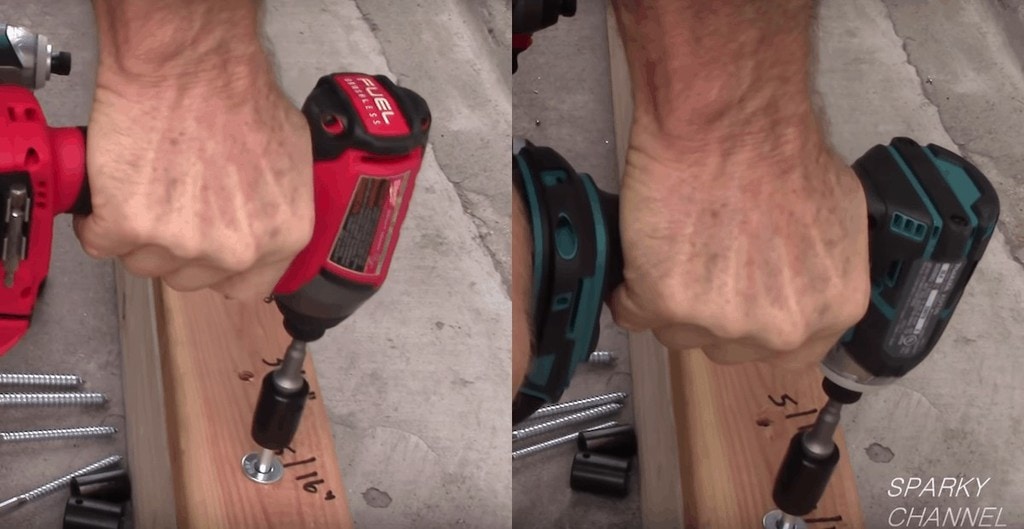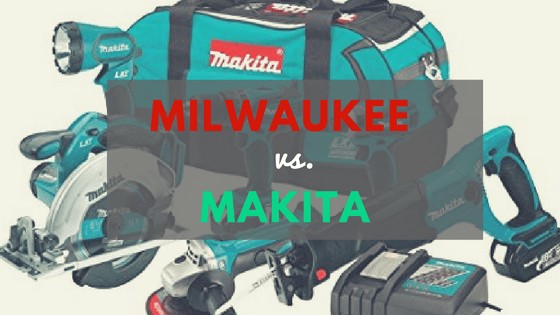
Which is better – Milwaukee or Makita?
Good question. In the world of power tools, they’re two of the heavyweights. Milwaukee, especially, in the past decade or so has really come to be regarded as the absolute best of the best; if you want to have an impressive tool collection, make your friends jealous, and blow your mind performance-wise, buy Milwaukee. Especially when you look to buy a scroll saw.
Top Rated Combo Kits
Naturally, however, if you want the best, then you pay for the best; Milwaukee tools overall are probably the most expensive of the bunch out there.
In this article, we’ll take a head-to-head look at Milwaukee vs. Makita, discuss a couple of their cordless tool combo kits, and try and decipher whether or not it’s really worth it to spend the extra dollars on that prestigious Milwaukee name.
Brief histories: Milwaukee vs. Makita
If you’re one of the bunch who prefers to support American companies, then Milwaukee is of course is your option here. The company was founded in 1924 in – you guessed it – Milwaukee, Wisconsin, and they started out primarily as an electric tool repair business until they made it big with a small electric hand drill that they originally designed for Henry Ford.
Makita, on the other hand, is a Japanese born company that coincidentally also started as an electric repair company. Truthfully, they probably ought to be regarded as the biggest innovators in the power tool industry – they were the first to introduce cordless tools way back in the late 70’s. So even though DeWalt may have revolutionized the cordless market in the early 90’s, they certainly weren’t the first to think of or engineer them.
Nowadays, both brands are massive conglomerates with manufacturing facilities all over the globe. Even though Milwaukee is headquartered in Brookfield, Wisconsin, the company is actually owned by Techtronic – a massive Hong-Kong based investment enterprise.
Manufacturing-wise, like we said both brands have production/assembly facilities across the globe. The majority of Milwaukee’s manufacturing is outsourced to China, while Makita has facilities in nine countries including Japan (where it’s headquartered), Germany, the U.S., and the United Kingdom.
Tool to tool comparison: Milwaukee vs. Makita
So, tool-wise, is Milwaukee better than Makita? Well, to put it frankly, yeah, they are. But (there’s always a but, isn’t there?), the question is, how much better are they? Are they really worth the eye-opening difference in price? Let’s take a close look and find out.
Below, we’ll do a head-to-head comparison of Milwaukee’s top of the line M18 Fuel cordless kit and Makita’s 18V LXT kit . Both are 6-tool kits, but the Milwaukee line is nearly 40% more expensive than the Makita line-up; let’s see if Milwaukee can put their money where their mouth is, and if their tools are really worth the staggering price tag.
Milwaukee 2896-26 18V M18 Fuel Cordless 6-Tool Combo Kit
Includes: ½” Hammer drill, ¼” Impact driver, 6 ½” circular saw, reciprocating saw, 4 ½” angle grinder, LED light, 2 batteries, charger, and two heavy-duty contractor bags (one small, one large).
Makita XT601 18V LXT Li-Ion Cordless 6-Piece Combo Kit
Includes: ½” Hammer drill, ¼” Impact driver, 6 ½” circular saw, reciprocating saw, 4 ½” angle grinder, LED light, 2 batteries, charger, and a Makita contractor/carrying bag.
So as you see, we’re dealing with the same exact set of tools in each kit. So Milwaukee had better darn-near blow the Makita line-up out of the water if they want to justify that price tag.
Turns out, they do. As soon as you hold one of the M18 Fuel cordless tools, the quality is recognizable immediately. They’re light and sleek in your hand, but they’re solid as a rock and there are zero implications that any corners were cut in materials/construction.
Where they really stand out though is in their performance. We had no trouble whatsoever drilling through mortar, mixing concrete, and drilling ⅜” holes in ⅛” angle iron (all jobs where we’d typically reach for a corded drill). The Makita LXT drill could do all of these too, albeit each task took longer and the battery took much more of a strain than the M18 battery did.
Whatever Milwaukee’s engineering crew is doing over there to produce these batteries, we reckon the whole department deserves a raise. They’ll charge up to 100% in less than an hour, and they’ll last throughout the day under normal workload without showing hardly any signs of fatigue.
Now, let’s not abandon the Makita LXT line-up; like we said, these are great tools that were able to do everything that the M18 Fuel line-up did.
The most obvious, noticeable difference came in the form of battery life – the Makita tools were straining and wearing down a lot quicker than the Fuel’s were under the heavier workloads like ripping stacks of decking, cutting ¼” PVC, and using a cut-off wheel on the angle grinder to cross-cut ⅛” steel tubing.
It’s gotta be said though, even though the Milwaukee line far and away out-performed the Makita, we put these tools through the wringer. The use and abuse we put them through was probably far more than they’d get out of your typical at home DIY’er.
The Bottom Line
So, is Milwaukee better than Makita?
I think we’ve answered that one pretty obviously. Now, are they worth their price tag? Oof. Not in our opinion. For the average, typical do-it-yourselfer, we can’t recommend going out and spending that kind of money on a cordless tool kit. For the purposes of probably 90% of homeowners/DIY’ers, the Makita line-up will provide with more than enough tool for what you need.
Now, if you’re building a house, or doing a complete demo/rebuild/add-on, or you’re a professional looking for tools to bring with you to the jobsite everyday, then by all means we recommend making the investment and going with Milwaukee – far and away the better tools. Just not something that the average joe will get enough use out of to justify the price.

